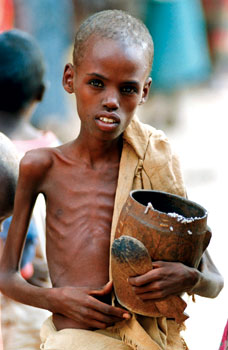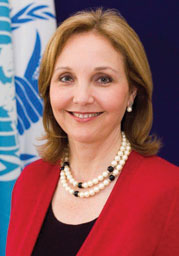Preventing Famine
Finance & Development, December 2011, Vol. 48, No. 4
![]() Sheeran on African famine
Sheeran on African famine
![]() IMF responds to disaster
IMF responds to disaster
The ongoing drought and famine in the Horn of Africa make a case for using global risk management to achieve food security

The images of emaciated children with eyes so hollow they seem to be looking death squarely in the face have faded from our morning papers and evening news programs. Yet, as I write this, more than 13 million people across the Horn of Africa are still in urgent need of assistance.
In southern Somalia alone, a combination of drought, conflict, and lack of humanitarian access has left 3 million people in crisis. Tens of thousands more could perish unless humanitarian assistance is allowed to flow freely. The famine stems not from the failure of the country's structures and systems, but from their complete absence.
On a recent trip to the region, I spoke with countless women who told me they had to leave their children behind to die as they made the long journey out of nowhere—villages in southern Somalia with no infrastructure, no safety nets, no aid programs—to reach aid hubs where other children who were strong enough for the journey could receive life-saving assistance. After two decades of civil war and the worst drought in 60 years, Somalis are faced with the terrible choices left to people without food: migrate or die.
Droughts like the current one in east Africa may not be preventable, but famines are. The international community has the tools to prevent the "roads of death" we are witnessing in parts of Somalia. In areas where the humanitarian community has access, millions of hungry people are being reached with life-saving action. We can't stop the droughts of tomorrow, but the deployment of lasting hunger solutions covering the full spectrum of food security—from support for smallholder farmers to antihunger safety net programs and an African-owned risk-pooling facility that helps protect the most vulnerable—will build resilience against crises and enable a timely response.
The first global humanitarian disaster, the 2008 food crisis, led to a structural change in food markets that had been stable for nearly 30 years. From 1969 to 2004, an ever-increasing food supply and lower prices resulted in a 40 percent decline in the  proportion of hungry people. Since 2008, however, risk and volatility in both price and supply have become the new norm. Many countries, including those in the Horn of Africa, lack shock absorbers such as national food reserves to deal with such volatility.
proportion of hungry people. Since 2008, however, risk and volatility in both price and supply have become the new norm. Many countries, including those in the Horn of Africa, lack shock absorbers such as national food reserves to deal with such volatility.
The estimated 80 percent of people in the developing world who have no safety net to ensure adequate access to food and nutrition during crises are forced to bear the environmental, political, and economic risks of everyday life on their dinner plates. Rather than allowing volatile food prices and supplies to harm those most in need in areas that are the most vulnerable, we must enhance food security through the use of global risk management.
Like all systems that face great risks, food security requires investment in the development and support of productive safety net programs that prevent the poor, through transfers and subsidies, from falling below a certain poverty level and protect them and their families against future crises.
The current drought is certainly terrible, but the number of people now in need of life-saving assistance in the Horn of Africa could be much higher. There are 4.5 million people in Ethiopia, Kenya, and Uganda who now benefit from productive safety nets thanks to United Nations World Food Program (WFP) government partnerships.
Through a community adaptation program called MERET, the Ethiopian government, with WFP support, has built a sustainable land management and rain catchment program that has vastly increased food production and mitigated the impact of the drought.
In the dry Karamoja region of northern Uganda, local communities are showing more resilience than they did during the 2007–09 droughts, thanks to a new system of communal food stocks that are replenished at harvest time. In Kenya, WFP is reaching over 670,000 children through a school-feeding safety net to help households in the drought-stricken northeast.
WFP's Purchase for Progress program buys from smallholder farmers and connects them to reliable markets. The result is greater agricultural production and improved business capacity. Between 2010 and 2011, nearly 25,000 metric tons of maize was purchased locally in support of the Ethiopian safety net program. Even in the Horn, WFP is saving lives with regionally procured food.
WFP is developing another risk-management tool, in partnership with the African Union Commission—with support from the International Fund for Agricultural Development, the Rockefeller Foundation, the U.K. Department for International Development, and the World Bank—to capitalize on the natural diversification of weather risk across the African continent. Known as the African Risk Capacity (ARC) Project, this African-owned disaster risk–financing facility will disburse resources to participating governments immediately after droughts or other natural disasters hit.
Preliminary findings suggest that if African countries were to pool their drought risk, the pool's capital requirement would be only half of what it would cost each country to finance its own reserves—making a pan-African risk pool an attractive financing mechanism in support of African food security. In the case of the Horn, such a facility would have enabled participating governments to tap funds in early 2011, as soon as it was clear that another rainy season had failed to materialize and the emergency was building. ARC will help reduce funding-related implementation delays, ensure timely and effective assistance for the most vulnerable, and minimize disruption to other critical in-country programs.
Emergency interventions are still the backup plan for life-saving food assistance when all else fails. The good news is the growing evidence of the tremendous benefit of recently developed nutrition products, or "smart foods," in the treatment of malnutrition in the Horn of Africa.
In Pakistan, WFP has developed a highly fortified paste from locally produced chickpeas. Development of a similar smart food is now expanding in Ethiopia. Such ready-to-use supplementary foods pack essential nutrients, and their production means jobs and opportunities for local communities. These power-packed foods require no water, cooking, or refrigeration and are saving lives in the Horn of Africa right now.
Addressing vulnerability is doable. In Dolo, Somalia, I met severely malnourished 18-month-old Sadak, who had traveled with his mother for 14 days from central Somalia to the border of Ethiopia in search of food. He was so severely malnourished that many thought he would not survive. Five weeks after receiving treatment, including the ready-to-use peanut-based supplement Plumpy'Sup, Sadak is healthy. His round face and uplifting smile are proof that this investment pays off in lives saved.
Research in the British medical journal The Lancet confirms that children who do not have adequate nutrition for the first 1,000 days from conception to the age of two are at risk for inadequate brain development and permanent damage. Hunger and malnutrition are long-term economic problems that reduce the earning potential of individuals and the human capital of nations.
A study conducted in Latin America by WFP with the Inter-American Development Bank and the UN Economic Commission for Latin America and the Caribbean shows that malnutrition can result in an average economic loss of 6 percent of GDP. Using the 6 percent average for the 36 countries with the highest burden of malnutrition, the figure is over $260 billion in lost GDP.
Such losses pale, however, next to the terrific return on investment from fighting malnutrition. The World Bank estimates that $10.3 billion a year in nutrition interventions in those same 36 countries would prevent more than 1.1 million child deaths, cut in half the prevalence of severe malnutrition, and result in 30 million fewer children suffering from stunted growth.
We need to counter the cynical view that nothing works. We need to make the case that fighting hunger and malnutrition is not just for humanitarians, but for finance ministers, presidents, and prime ministers. This is why I am so pleased that French President Sarkozy and other leaders have put food security on the Group of Twenty agenda. The IMF's commitment to flexible and timely response to sudden emergencies is another important step toward future collaboration on the establishment of global risk management of food security.
Working together to address vulnerability over the longer term will ensure that children like Sadak do not pay the price for global, regional, and national disorder. The world has the knowledge and the tools not only to prevent famines but to end malnutrition and hunger now. It's not only about compassion, but about creating jobs up the entire supply chain and managing risk while saving lives.■


